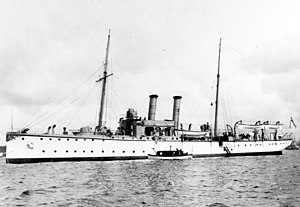
Back سفينة بانثر Arabic SMS Panther Czech Panther (Schiff, 1902) German SMS Panther Spanish اساماس پانتر Persian SMS Panther French פנתר (אונייה, 1901) HE SMS Panther HT SMS Panther (ágyúnaszád) Hungarian SMS Panther (1901) Italian
 SMS Panther
| |
| History | |
|---|---|
| Name | SMS Panther |
| Namesake | Panthera |
| Builder | Kaiserliche Werft, Danzig |
| Laid down | July 1900 |
| Launched | 1 April 1901 |
| Commissioned | 15 March 1902 |
| Decommissioned | 31 March 1931 |
| Fate | Sold and scrapped 1931 |
| General characteristics | |
| Class and type | Iltis-class gunboat |
| Displacement | |
| Length | 66.9 m (219 ft 6 in) o/a |
| Beam | 9.7 m (31 ft 10 in) |
| Draft | 3.54 m (11 ft 7 in) |
| Installed power |
|
| Propulsion | |
| Speed | 13.5 knots (25.0 km/h; 15.5 mph) |
| Range | 3,400 nmi (6,300 km; 3,900 mi) at 9 knots (17 km/h; 10 mph) |
| Complement |
|
| Armament | |
| Armor | Conning tower: 8 mm (0.31 in) |
SMS Panther was one of six Iltis-class gunboats built for the German Kaiserliche Marine (Imperial Navy) in the late 1890s and early 1900s. The ships were built to modernize the German gunboat force that was used to patrol the German colonial empire. They were ordered in three groups of two ships, each pair incorporating design improvements. Panther, along with Eber, was armed with a main battery of two 10.5 cm (4.1 in) guns, had a top speed of 13.5 knots (25.0 km/h; 15.5 mph), and could cruise for 3,400 nautical miles (6,300 km; 3,910 mi).
Panther spent most of her career abroad, where she was involved in a number of international disputes. She was initially sent to the American Station after entering service in 1902, and she was soon sent to intervene in the Markomannia incident, where she sank the Haitian gunboat Crête-à-Pierrot. Panther was next involved in the Venezuelan crisis of 1902–1903, during which she participated in the bombardment of Fort San Carlos. Panther returned to Haiti in 1904 to pressure the Haitian government to pay a settlement after the murder of a German diplomat in the country. In 1905 and 1906, the ship toured South America, steaming as far south as Paraguay. She was transferred to German West Africa in mid-1907.
The ship patrolled Germany's West African colonies for the next four years, largely uneventfully. Recalled to Germany for repairs in 1911, she stopped in Agadir, Morocco, at the request of the Foreign Office, touching off the Agadir Crisis, the most significant incident that involved Panther. The resulting international uproar created a war scare that significantly worsened Anglo-German relations. After repairs in Germany, Panther returned to Africa for another tour from 1912 to 1914, arriving back in Germany weeks before the start of World War I. She was used as a patrol vessel in the western Baltic Sea during the war, but she saw no action. After the war, she was retained by the new Reichsmarine (Navy of the Realm) for use as a survey ship. Decommissioned in 1926, she was eventually sold to ship breakers in 1931 and dismantled.